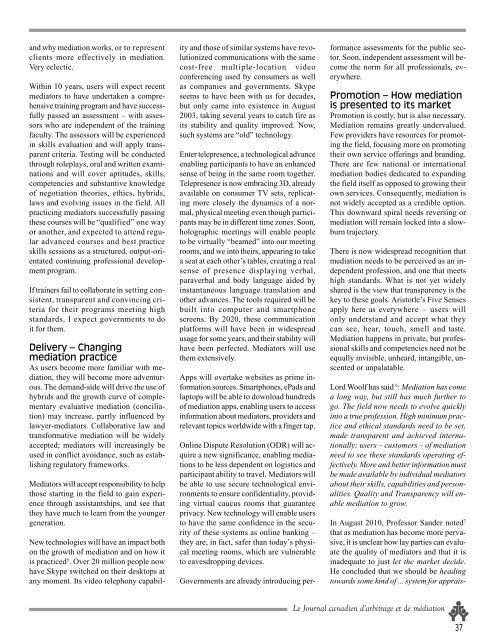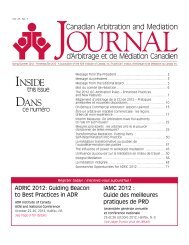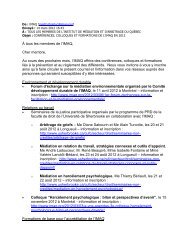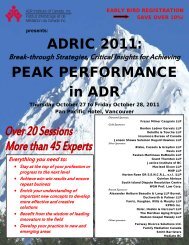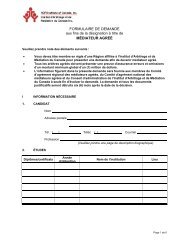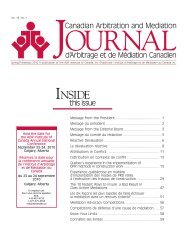Printemps 2011 - ADR Institute of Canada
Printemps 2011 - ADR Institute of Canada
Printemps 2011 - ADR Institute of Canada
You also want an ePaper? Increase the reach of your titles
YUMPU automatically turns print PDFs into web optimized ePapers that Google loves.
and why mediation works, or to representclients more effectively in mediation.Very eclectic.Within 10 years, users will expect recentmediators to have undertaken a comprehensivetraining program and have successfullypassed an assessment – with assessorswho are independent <strong>of</strong> the trainingfaculty. The assessors will be experiencedin skills evaluation and will apply transparentcriteria. Testing will be conductedthrough roleplays, oral and written examinationsand will cover aptitudes, skills,competencies and substantive knowledge<strong>of</strong> negotiation theories, ethics, hybrids,laws and evolving issues in the field. Allpracticing mediators successfully passingthese courses will be “qualified” one wayor another, and expected to attend regularadvanced courses and best practiceskills sessions as a structured, output-orientatedcontinuing pr<strong>of</strong>essional developmentprogram.If trainers fail to collaborate in setting consistent,transparent and convincing criteriafor their programs meeting highstandards, I expect governments to doit for them.Delivery – Changingmediation practiceAs users become more familiar with mediation,they will become more adventurous.The demand-side will drive the use <strong>of</strong>hybrids and the growth curve <strong>of</strong> complementaryevaluative mediation (conciliation)may increase, partly influenced bylawyer-mediators. Collaborative law andtransformative mediation will be widelyaccepted; mediators will increasingly beused in conflict avoidance, such as establishingregulatory frameworks.Mediators will accept responsibility to helpthose starting in the field to gain experiencethrough assistantships, and see thatthey have much to learn from the youngergeneration.New technologies will have an impact bothon the growth <strong>of</strong> mediation and on how itis practiced 5 . Over 20 million people nowhave Skype switched on their desktops atany moment. Its video telephony capabilityand those <strong>of</strong> similar systems have revolutionizedcommunications with the samecost-free multiple-location videoconferencing used by consumers as wellas companies and governments. Skypeseems to have been with us for decades,but only came into existence in August2003, taking several years to catch fire asits stability and quality improved. Now,such systems are “old” technology.Enter telepresence, a technological advanceenabling participants to have an enhancedsense <strong>of</strong> being in the same room together.Telepresence is now embracing 3D, alreadyavailable on consumer TV sets, replicatingmore closely the dynamics <strong>of</strong> a normal,physical meeting even though participantsmay be in different time zones. Soon,holographic meetings will enable peopleto be virtually “beamed” into our meetingrooms, and we into theirs, appearing to takea seat at each other’s tables, creating a realsense <strong>of</strong> presence displaying verbal,paraverbal and body language aided byinstantaneous language translation andother advances. The tools required will bebuilt into computer and smartphonescreens. By 2020, these communicationplatforms will have been in widespreadusage for some years, and their stability willhave been perfected. Mediators will usethem extensively.Apps will overtake websites as prime informationsources. Smartphones, ePads andlaptops will be able to download hundreds<strong>of</strong> mediation apps, enabling users to accessinformation about mediators, providers andrelevant topics worldwide with a finger tap.Online Dispute Resolution (ODR) will acquirea new significance, enabling mediationsto be less dependent on logistics andparticipant ability to travel. Mediators willbe able to use secure technological environmentsto ensure confidentiality, providingvirtual caucus rooms that guaranteeprivacy. New technology will enable usersto have the same confidence in the security<strong>of</strong> these systems as online banking –they are, in fact, safer than today’s physicalmeeting rooms, which are vulnerableto eavesdropping devices.Governments are already introducing performanceassessments for the public sector.Soon, independent assessment will becomethe norm for all pr<strong>of</strong>essionals, everywhere.Promotion – How mediationis presented to its marketPromotion is costly, but is also necessary.Mediation remains greatly undervalued.Few providers have resources for promotingthe field, focusing more on promotingtheir own service <strong>of</strong>ferings and branding.There are few national or internationalmediation bodies dedicated to expandingthe field itself as opposed to growing theirown services. Consequently, mediation isnot widely accepted as a credible option.This downward spiral needs reversing ormediation will remain locked into a slowburntrajectory.There is now widespread recognition thatmediation needs to be perceived as an independentpr<strong>of</strong>ession, and one that meetshigh standards. What is not yet widelyshared is the view that transparency is thekey to these goals. Aristotle’s Five Sensesapply here as everywhere – users willonly understand and accept what theycan see, hear, touch, smell and taste.Mediation happens in private, but pr<strong>of</strong>essionalskills and competencies need not beequally invisible, unheard, intangible, unscentedor unpalatable.Lord Woolf has said 6 : Mediation has comea long way, but still has much further togo. The field now needs to evolve quicklyinto a true pr<strong>of</strong>ession. High minimum practiceand ethical standards need to be set,made transparent and achieved internationally;users – customers – <strong>of</strong> mediationneed to see these standards operating effectively.More and better information mustbe made available by individual mediatorsabout their skills, capabilities and personalities.Quality and Transparency will enablemediation to grow.In August 2010, Pr<strong>of</strong>essor Sander noted 7that as mediation has become more pervasive,it is unclear how lay parties can evaluatethe quality <strong>of</strong> mediators and that it isinadequate to just let the market decide.He concluded that we should be headingtowards some kind <strong>of</strong> ... system for apprais-Le Journal canadien d'arbitrage et de médiation37


